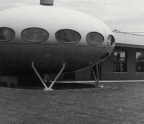On the Banks of the Lemonweir

IN 1928, EIGHT YEARS DEEP INTO PROHIBITION, Clinton Price, the district attorney for Juneau County, Wisconsin, notified state and federal agents about the presence of a moonshine still on the Henry Evans farm, roughly four miles northwest of Kilbourn City (now Wisconsin Dells). Following Price’s word, state prohibition commissioner Roland W. Dixon directed a raid on the Kilbourn still with twenty-four state and federal officers. On November 27, 1928, officers fired on the moonshiners, forcing them from the barn housing the still into an open field. Although the men were captured without bloodshed, this was far from the end of the story. Seven people were arrested at the Kilbourn still and taken to the Portage County jail. Among the items confiscated were the 1,000-gallon still, a truck loaded with 1,400 gallons of moonshine, a 1,000-gallon boiler, 5,000 gallons of mash, and a large supply of fuel. After Kilbourn, the officers went on to raid a smaller 50-gallon still in Necedah and a still five miles south of Mauston in Lindina Township reported to have the same capacity as the Kilbourn still. The later raids did not yield much, as most of the equipment had been removed before officers arrived.1
Noticeably absent from the raids was Juneau County sheriff Lyall Wright. As courtroom testimony would later reveal, at the time of the raids Wright was suspected of involvement in trafficking the illegal liquor. The discovery of the Kilbourn still, one of the largest in the state, and the likely collusion of a well-regarded sheriff in this small Wisconsin community together reveal how far the tendrils of illegal activity reached during Prohibition to affect small rural communities. Prohibition created a divide that drove formerly law-abiding citizens to crime, connecting some to urban networks that used intimidation and even violence to ensure the underground trade prospered. The Kilbourn incident was just the beginning of a sprawling story of corruption, organized crime, and murder in Juneau County.
Each man arrested at the Kilbourn still was held under a $2,000 bond.2 In the early years of Prohibition, fines for violating the dry law were generally under $500 and jail time was minimal. Bootleggers considered this a cost of doing business.3 Often, if a case came to trial, the offenders would be set free under a sympathetic county judicial system; jurors might find the accused innocent even if they were arrested with a truck full of liquor. As the years progressed and more money was spent on trying to enforce the law, fines and jail time became more significant.4
During Prohibition, crime became rampant in cities such as Chicago and Milwaukee. Gangsters Al Capone and George “Bugs” Moran, rival gang leaders from Chicago, didn’t hesitate to kill to protect their territories and their profits. While these larger cities received a significant amount of national attention, rural areas were just as involved in bootlegging. According to historian Karen Blumenthal, “Perhaps the biggest supply of all came from homemade moonshine, distilled in kitchens and living rooms and in secluded spaces across rural America in quantities too large to begin to measure.” By nature, rural outfits were easier to hide because they had fewer eyes on them, as long as those in the know could keep their secrets. Urban bootlegging operations used rural stills to meet their demands. The Kilbourn still had been making up to 1,500 gallons of moonshine daily, and its product was reported to have been of excellent quality. The outfit was highly profitable: with moonshine selling at six dollars a gallon, the still running at full capacity could gross more than $60,000 per week. The risk was high, but to many the payout was worth it. Farmers often rented their farms and buildings to bootleggers for payments that helped During World War I, many farmers had expanded to meet the demand for more food. Once the war was over, prices dropped and many lost their farms or were on the verge of bankruptcy. Prohibition offered a way, albeit illegal, to help float the family farm during difficult times; the business also brought money into the household for much-needed shoes for the kids, a washing machine to make life easier, or a new vehicle.
You’re reading a preview, subscribe to read more.
Start your free 30 days



